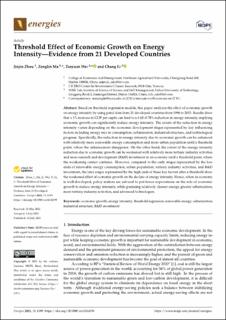| dc.description.abstract | Based on threshold regression models, this paper analyzes the effect of economic growth on energy intensity by using panel data from 21 developed countries from 1996 to 2015. Results show that a 1% increase in GDP per capita can lead to a 0.62–0.78% reduction in energy intensity, implying economic growth can significantly reduce energy intensity. The extent of the reduction in energy intensity varies depending on the economic development stages represented by key influencing factors including energy mix in consumption, urbanization, industrial structure, and technological progress. Specifically, the reduction in energy intensity due to economic growth can be enhanced with relatively more renewable energy consumption and more urban population until a threshold point, where the enhancement disappears. On the other hand, the extent of the energy intensity reduction due to economic growth can be weakened with relatively more tertiary industry activities and more research and development (R&D) investment in an economy until a threshold point, where the weakening cannot continue. However, compared to the early stages represented by the low ends of renewable energy consumption, urban population, tertiary industry activities, and R&D investment, the later stages represented by the high ends of these key factors after a threshold show the weakened effect of economic growth on the decline of energy intensity. Hence, when an economy is well-developed, policy makers are advised to put fewer expectations on the role of economic growth to reduce energy intensity, while pursuing relatively cleaner energy, greater urbanization, more tertiary industry activities, and advanced technologies | en_US |

